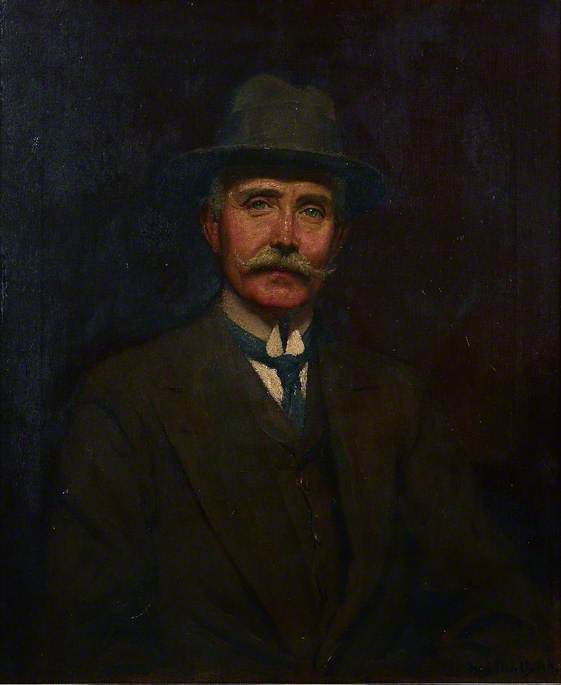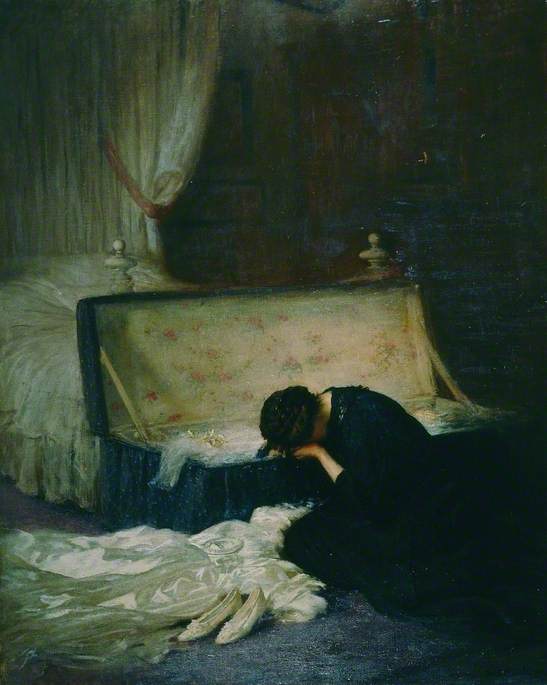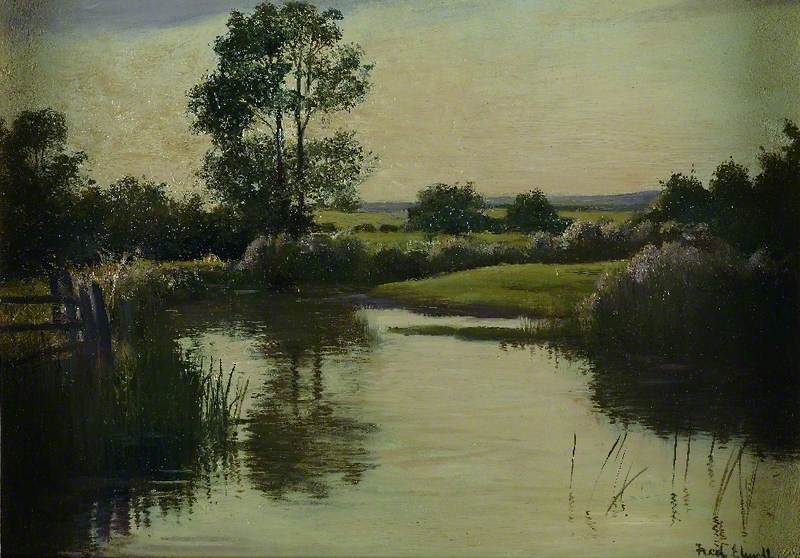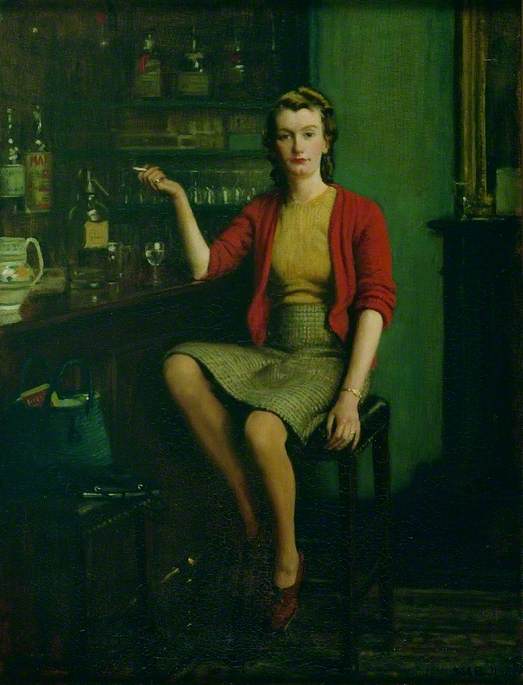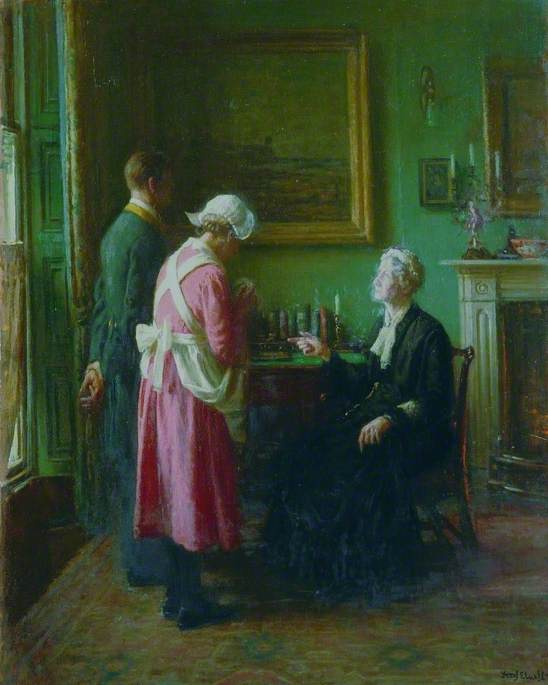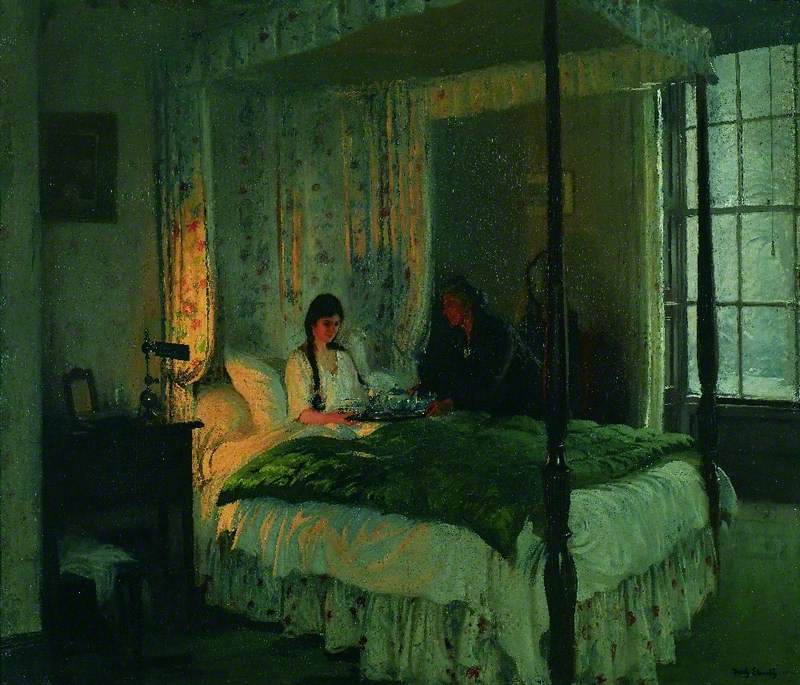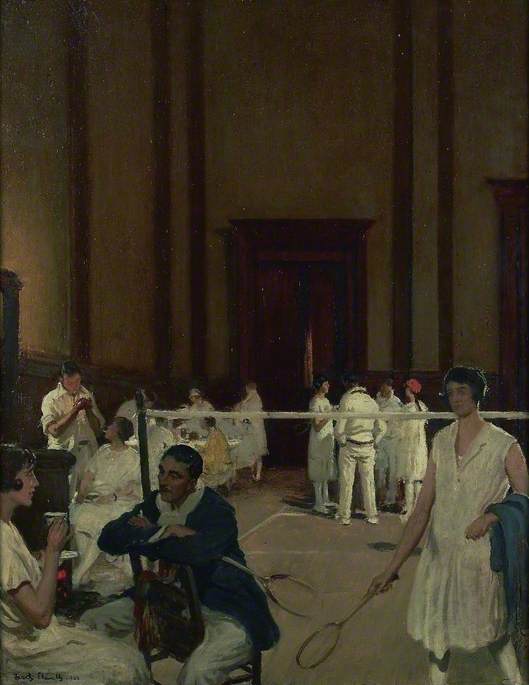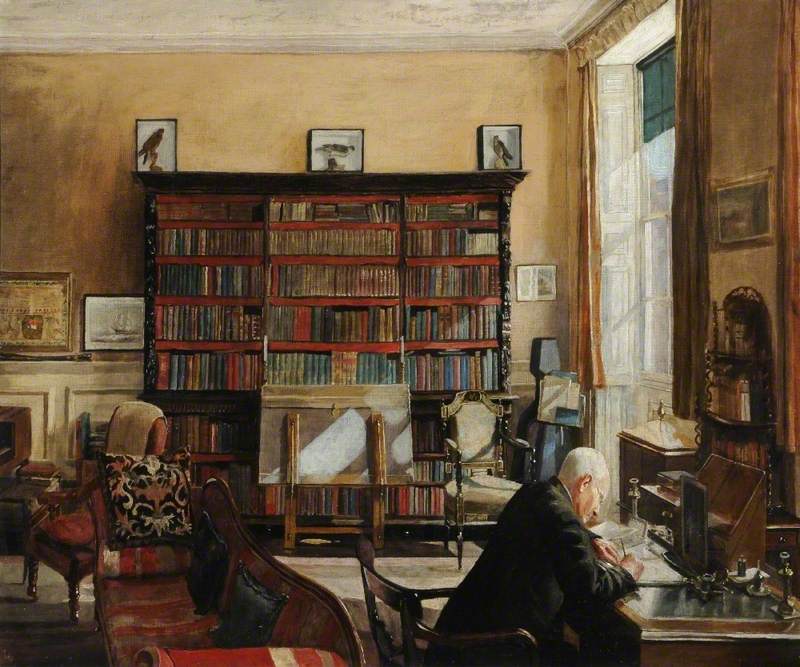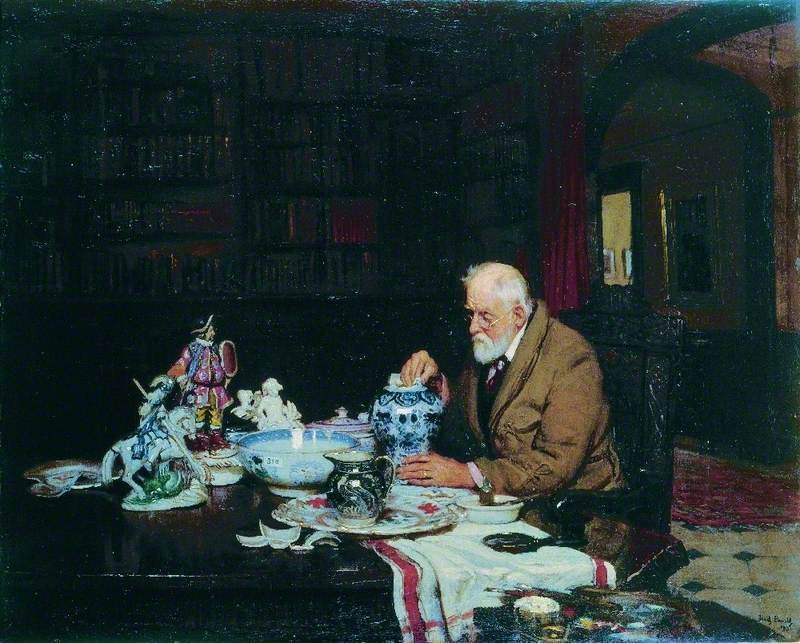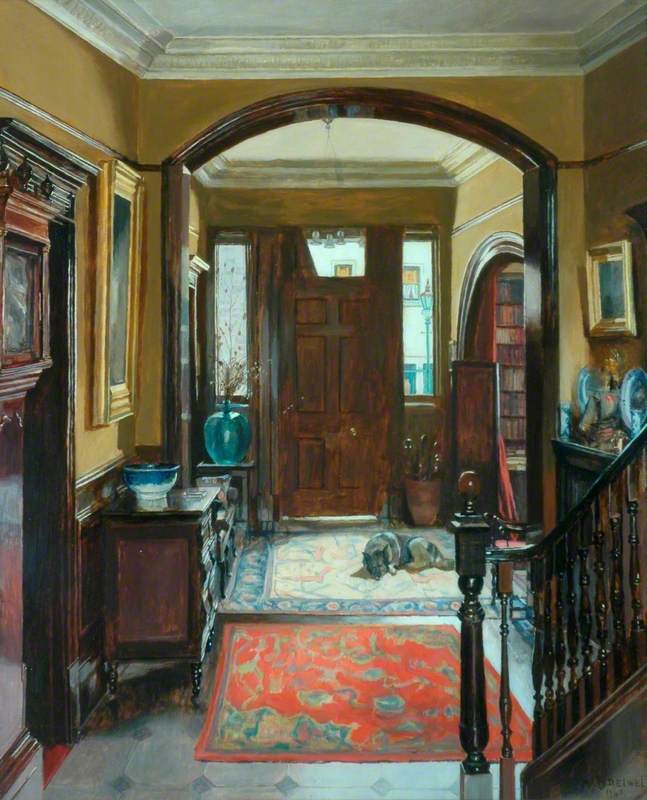Fred Elwell RA was born in Beverley on the 29 June 1870. This year marks the 150th Anniversary since his birth.
Elwell was popular both in East Yorkshire and further afield in London and on the Continent. Ferens Art Gallery has a number of his most enduringly popular paintings in the permanent collection, including his masterpiece, The First Born, (1913). He was a talented realist artist, whose depictions of everyday life in East Yorkshire from over a century ago continue to draw a strong emotional reaction from audiences.
-
Self Portrait 1911
From his early career, Elwell showed a flair for portraiture, he painted many commissions event from the Royal Family. He was talented in capturing a persons’ likeness and expressing their individual personalities. Elwell often returned to self-portraiture. He expressed his many faces, culminating in his final frame of 1933 depicting himself poised to paint a canvas. The confident man in this painting, shows Elwell as a well-known artist regularly exhibiting at the Royal Academy.
Frederick William Elwell (1870–1958)
Oil on canvas
H 76 x W 63.5 cm
Ferens Art Gallery
-
The Landlord 1935
Elwell's painting represents a familiar scene. Confidently looking directly at the viewer, the landlord holds a funnel over a keg, and grips a copper flagon in his left hand. Alike his other paintings, Elwel used local models and scenes; The landlord was modeled by John Booth, a butler who grew up in Beverley, and in an interview with Beverley Guardian, Elwell revealed that the scene was taken at the Buck Inn, Driffield. Elwell demonstrates his considerable skill, painting the lime green fabric waistcoat and gleaming glass bottles. If you look close enough, you can see the recognisable Martini and Red Bass labels in the background.
Frederick William Elwell (1870–1958)
Oil on canvas
H 137.2 x W 83.8 cm
Ferens Art Gallery
-
The Wedding Dress 1911
The Wedding Dress is a highly realistic painting. This faithful depiction of life adds to the emotive subject and touches the viewer with the woman's sorrow. Elwell intensifies the sorrow of the painting by contrasting the dark mourning cloths with the bright white satin wedding dress. Such emotive subjects were popular in the 19th and 20th century.
The model was Violet Prest, a costumier in Beverley. Fate dealt an ironic blow, when, shortly after posing, she lost her husband in the First World War, after only a short marriage.
Frederick William Elwell (1870–1958)
Oil on canvas
H 128.3 x W 102.5 cm
Ferens Art Gallery
-
Landscape c.1900
Landscapes formed an important part of Elwell's work. This landscape appears to date from the early part of the century when Elwell explored the flatness and expansive skies and rivers of the East Riding of Yorkshire. It is likely that his practice of painting out of doors began when he was a student in France in the 1890s. Interestingly, most of his landscapes were painted on a similarly small scale probably because of his practice of painting outdoors.
Frederick William Elwell (1870–1958)
Oil on oak panel
H 29.2 x W 41 cm
Ferens Art Gallery
-
In a Bar 1943
Sitting comfortably on a bar stool, with cigarette in hand and gin and tonic in her glass, the woman nonchalantly gazes at the viewer. Her curled hair, clothing and confident position conveys the independent character of a post war 1940s woman. Elwell gained a successful reputation painting portraits, including commissions from the Royal Family. However, he painted portraits of familiar faces for his own pleasure. The model for this painting was Murial Fox, his tenant of No.6 North Bar Without and a common feature on the bar stool on which Elwell painted her. Shortly before she was painted, Muriel had given birth to her daughter, and it is speculated that she was tucked up in a basket behind the bar.
Frederick William Elwell (1870–1958)
Oil on canvas
H 82 x W 62.5 cm
Ferens Art Gallery
-
The First Born 1913
The First Born is a firm Ferens Favourite. This Victorian depiction of family life sees a father rushing, still in his work clothes, to see his new born daughter. The painting is imbued with the symbolism of new life through spring symbolism in the flowers, lighting and open window. This light and airy atmosphere can be linked to experimentation with French Impressionism. Elwell merged Victorian sentimentality with the realism of contemporary social ideas; he paints the disorder of family life, with a strewn magazine and half opened curtains. The mother does not differ to her husbands’ gaze, unlike her Victorian counterparts were depicted. The child is painted from a live baby, Murial Holtby, rather than a doll.
Frederick William Elwell (1870–1958)
Oil on canvas
H 102.3 x W 127.3 cm
Ferens Art Gallery
-
The Housekeeper's Room 1911
The domestic setting of a home was a fashionable subject for artists in the early 1900s. This setting is taken from Bar House, Beverley, Elwell's future home. Elwell often visited the house to care for Alfred, Mary's ill husband. Mary and Fred were to marry after his death.
Interestingly, the figures in the painting conflict with the date inscribed on it. Emily Rowley is thought to be the maid, although she lived in the area in 1930. The housekeepers features resemble those of Elizabeth Chapman, Elwell's housekeeper in the 1930s. It appears that the painting was modified between the date inscribed on it and when it was exhibited in the Royal Academy Summer Exhibition in 1954.
Frederick William Elwell (1870–1958)
Oil on panel
H 113 x W 92 cm
Ferens Art Gallery
-
The War Worker 1919
This bedroom houses a young woman being fed breakfast in her four-poster bed, by her mother before starting her day as a ‘land girl’. Of interest in the painting is the warm amber glow of the electric light. The setting is in the Elwell’s home, Bar House, where Fred and Mary had purchased their own electric generator the year before. Alike many of his paintings, his models were known personally to him. The girl in this Phyllis Downham, god-daughter to Mary Elwell.
Frederick William Elwell (1870–1958)
Oil on canvas
H 108 x W 127.8 cm
Ferens Art Gallery
-
Still Life: The Pickwick Club c.1950
Throughout all his work Elwell’s talent of painting still life is evident. This came from his training at the nearby Lincoln School of Art and his studies of Dutch art in Antwerp. Still life was a regular feature in all of Elwell’s paintings, be them portraiture or narrative. The painting takes its title from the picture of the Pickwick Club on the back wall of the canvas. The other objects of a silver salver, candelabra, decanter and pipes, conveyed the jovial atmosphere of the gentleman’s club.
Frederick William Elwell (1870–1958)
Oil on plywood panel
H 71.4 x W 92 cm
Ferens Art Gallery
-
The Badminton Court 1926
Looking at this painting, you could imagine it as a contemporary photograph. Elwell captures the players in a court between games, with social groups divided among the foreground and background. Some even commented that the casual man astride in the foreground, looked as if he had just borrowed a racquet just to get near the girls in the team. Elwell captures the social interaction and poses of the figures; the badminton seems simply the vehicle to do it. The court, probably part of the Assembly Rooms in Norwood, Beverley, frame the game.
Frederick William Elwell (1870–1958)
Oil on plywood
H 91.5 x W 71 cm
Ferens Art Gallery
-
Interior Study 1937 (?)
This light filled interior study was painted by Fred Elwell's wife, Mary. Mary was a talented painter in her own right. She exhibited no less than 58 paintings at the prestigious Royal Academy. Many of her paintings depict familiar interiors in Beverley. The scene for the Interior Study has never been confirmed, but the character bears similarities to Fred's father, James Elwell.
Mary Dawson Elwell (1874–1952)
Oil on canvas
H 63.2 x W 76.5 cm
Ferens Art Gallery
-
The Last Purchase (The New Purchase) 1921
This painting shows each of Elwell’s talents as a painter: superb portraiture, detailed still life and an eye for realistic composition. The interior surrounds the painters’ Father, James Elwell, among his spoils from the latest auction as can be identified with the lot-number still affixed to his treasures. It is with great respect with which Elwell represents his Father when he captures his delicate craftsmanship and thoughtful joy. It was 5 years after this painting that James died. Poignantly, Elwell changed the title from ‘New’, to ‘Last’ purchase.
Frederick William Elwell (1870–1958)
Oil on canvas
H 102 x W 127 cm
Ferens Art Gallery
